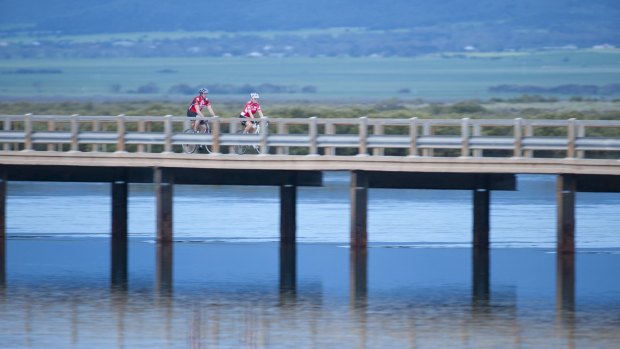This was published 9 years ago
Port Pirie, South Australia: Travel guide and things to do

Port Pirie, SACredit: Adam Bruzzone
Located on the eastern shore of Spencer Gulf 229 km north of Adelaide, Port Pirie economy is driven by the huge silver, lead and zinc smelters which process the raw ore brought from Broken Hill and the large port which provides transportation for both the metal and rural industries which dominate the town.
Port Pirie proudly announces itself as 'The City of Friendly People' although the first sight one has is not of people but of the huge oil tanks on the outskirts of town and the grain silos and the chimney at the smelter. It would be easy for the traveller to feel that here was a big smelly industrial city and keep driving but this would be to miss some fascinating buildings and a genuinely beautiful and gracious main street.
Prior to European settlement the district was known as 'tarparrie' (possibly meaning 'muddy creek') by the local Nuguna Aborigines. The area was first explored by Matthew Flinders who came up the Spencer Gulf in 1802. In 1839 Edward Eyre led an expedition from around Port Augusta north to Lake Eyre and in 1846 J. A. Horrocks discovered a pass (Horrocks Pass) through the Flinders Ranges and down onto the coastal plain.
The muddy creek upon which the town's port was based was originally known as Samuel's Creek after its discoverer, Samuel Germein. Around 1845 the schooner John Pirie (it was owned by John Pirie one of the directors of the South Australian Company) made its way up the creek and managed to take on board a flock of sheep which is transported across Spencer Gulf to near Port Lincoln. It was as a result of this that Governor Robe named the site Port Pirie. In 1848 some 85 acres were sold in the area for the modest sum of £85.
Settlement of the town was slow and it wasn't until 1871 that the town was surveyed and five years later it was declared a municipality.
The critical event in the town's history was the construction of the smelting works in 1889. This ensured the town's continuing future. It was greatly compounded by the completion of the Broken Hill Associated Smelters Pty Ltd smelting works in 1915. By 1934 it was the largest single-unit lead-smelting works in the world.
Around the turn of the century the connection between Port Pirie and Broken Hill was so strong that the author Ion Idriess recalls 'lucky families from the Silver City enjoyed their Christmas holidays at Port Pirie ... Dad somehow managed nearly every year to scrape the few pounds together and send us entranced kids and harassed Mum by train to the long-dreamed-of fairy land by the shore of the sea'.
In 1937 the broad gauge railway line to Adelaide was completed and by 1953 Port Pirie was declared South Australia's first provincial city. Today it is South Australia's second largest port and is characterised by a gracious main street and some interesting and unusual historic buildings.
Things to see
Port Pirie Regional Tourism and Arts Centre
Located on the corner of Ellen and Mary Elie Streets the Port Pirie Regional Tourism and Arts Centre is an ideal starting point for anyone wishing to explore Port Pirie and the surrounding region. It has plenty of tourist information as well as galleries which have good examples of local, national and international art. It is possible to get a Heritage Walk brochure here which provides a map and information on the town's major historic sites. For more information contact (08) 8633 8700.
National Trust Historic and Folk Museum
By any measure this is an extraordinary building. Located in Ellen Street in a combination of buildings which include the old Customs House, the Victorian pavilion-style railway station and the Old Police Station. It is a good quality National Trust museum which interesting displays of local history and memorabilia.
The old Customs House (1882) has been developed so it looks like a house from around 1900. the old Railway Station (1902) contains a scale model of Port Pirie's smelters and a blacksmith's display. And the old Police Station (1892) has been developed so the south side is a series of miniature shopfronts.
Carn Brae
Located at 32 Florence Street 'Carn Brae' was built in 1905 for W. H. Moyle who named it after Castle Carnbrae in Cornwall near where the Moyle family had lived. It has a number of unusual features including valuable stained glass windows and a tall widow's walk dominating the roof line. It is not open to the public.
Memorial Park
Located in Norman Street, and with the anchor of the 'John Pirie' (after which the town was named) as its centrepiece, the Memorial Park was dedicated to veterans of recent wars - the Korean, Malayan, Borneo and Vietnam wars. It is believed to be the first Memorial Park in Australia to commemorate those battles.
Family Hotel
Located at 134 Ellen Street There is a great deal of charm about the small Family Hotel (built in 1904) in the main street. It has some very attractive with well preserved lace ironwork on the verandah.
Port Pirie Festival of Country Music
Each September/October Port Pirie is host to one of Australia's largest and most successful Country Music Festivals which features both local and international artists.
Blessing of the Fleet
On the second Sunday in September the statue of Madonna Dei Martiri is carried to the local wharves by members of the Italian community and the town's fishing fleet is blessed.
Tourist Information
Port Pirie Tourist Information Centre
3 Mary-Elie St
Port Pirie SA 5540
Telephone: (08) 8633 8700
Sign up for the Traveller Deals newsletter
Get exclusive travel deals delivered straight to your inbox. Sign up now.